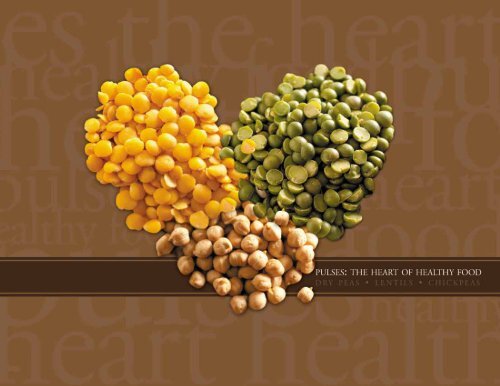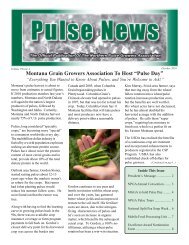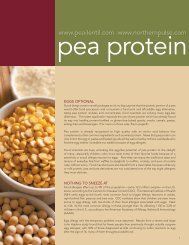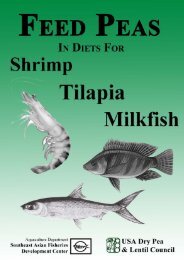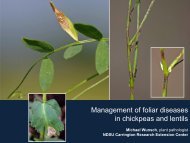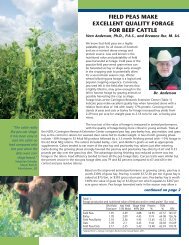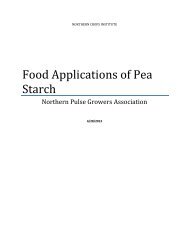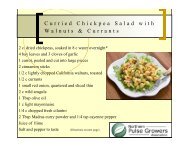Pulses: The Heart of Healthy Food - Northern Pulse Growers ...
Pulses: The Heart of Healthy Food - Northern Pulse Growers ...
Pulses: The Heart of Healthy Food - Northern Pulse Growers ...
You also want an ePaper? Increase the reach of your titles
YUMPU automatically turns print PDFs into web optimized ePapers that Google loves.
have been part <strong>of</strong> the<br />
world’s cuisine for<br />
centuries, dating back to the<br />
exotic spice trading days. But<br />
the ancients who first cultivated<br />
these soil-enriching crops as<br />
early as 6,000 B.C. wouldn’t have<br />
guessed they were growing the<br />
world’s first superfood. <strong><strong>Pulse</strong>s</strong><br />
are the nutritionally-packed seeds<br />
<strong>of</strong> legumes and include dry peas,<br />
lentils and chickpeas. Today they<br />
continue to form the foundation <strong>of</strong><br />
healthy diets in the Mediterranean,<br />
India, Africa, Australia, the Middle<br />
East and South America.<br />
Today there’s a gastronomical movement that is<br />
putting pulses on the American plate to meet<br />
growing consumer desires for healthier food<br />
that is both adventurous and familiar. Naturally<br />
high in protein and fiber, pulses are also packed<br />
with complex carbohydrates, antioxidants,<br />
vitamins, and minerals like calcium, iron, zinc,<br />
folate, potassium and magnesium. Research has<br />
confirmed that regular consumption <strong>of</strong> pulses<br />
reduces the risk <strong>of</strong> chronic diseases such as<br />
heart disease, diabetes and certain cancers and<br />
may even help combat obesity. But Americans<br />
are quite good at snubbing healthy choices if<br />
it means sacrificing the fun and flavor <strong>of</strong> food.<br />
<strong><strong>Pulse</strong>s</strong> provide a way to have it all.<br />
Bringing the Mediterranean Diet home. <strong>The</strong><br />
flavor pr<strong>of</strong>ile <strong>of</strong> pulses is distinct, yet neutral<br />
enough to be exceedingly flexible—a true<br />
chameleon <strong>of</strong> foods. <strong>The</strong>y perfectly adopt the<br />
flavor intention <strong>of</strong> the creative cook, be that<br />
sweet, savory or spicy. That also makes them a<br />
valuable R&D tool in the effort to put a healthy<br />
face on old favorites—from french fries to cereal,<br />
pasta to pizza crust—and still mirror traditional<br />
expectations <strong>of</strong> taste and texture.<br />
What’s more, pulses <strong>of</strong>fer a way to address the<br />
growing demand for foods that fit special diets.<br />
Vegetarians, people with diabetes and celiac<br />
disease and the millions <strong>of</strong> Americans allergic<br />
to the top eight (milk, wheat, soy, egg, treenut,<br />
peanut, fish and shellfish) want more nutritious<br />
choices. <strong><strong>Pulse</strong>s</strong> deliver. Gluten-free, with high<br />
quality vegetarian protein, chickpeas, lentils<br />
and dry peas are low allergen and low-glycemic<br />
ingredients. Product innovators have a plethora<br />
“If you can look into the seeds <strong>of</strong> time,<br />
And say which grains will grow and which will not...”<br />
— William Shakespeare<br />
1
<strong>of</strong> pulse products to choose from: Use these powerful precooked seeds ground into flour or whole<br />
or enlist a component in the form <strong>of</strong> a starch, fiber or protein concentrate or isolate.<br />
Five-star Culinary to the Corner Diner<br />
<strong>The</strong>re’s no way around the obvious: Healthier diets dictate a change in ingredients. But whether<br />
you’re trying to satisfy an adventurous palate or match familiar expectations <strong>of</strong> taste and texture,<br />
pulses can help meet the challenge <strong>of</strong> better nutrition.<br />
What starts at the CIA when a world-class chef creates Chickpea Fritters with<br />
Romesco Sauce eventually results in a healthier, pulse-fortified pizza crust at<br />
the local quick-serve restaurant (QSR).<br />
U.S. culinary trends take root at white tablecloth restaurants then trickle down through the chains<br />
and other volume food service establishments. Chefs from these operations are influenced from<br />
events like the World <strong>of</strong> <strong>Healthy</strong> Flavors leadership retreat hosted by the Culinary Institute <strong>of</strong> America<br />
(CIA). With Chinese, Mexican and Italian fare now mainstream in America, classically-trained chefs<br />
at their Greystone, CA, headquarters stand ready to take Asian, Latin and Mediterranean cuisine<br />
to the next level. Of late, they’ve been highlighting the “healthy magic” in dry peas, lentils and<br />
chickpeas and the exciting potential <strong>of</strong> pulses for product innovation.<br />
Great culinary history. Americans are more adventurous eaters today, growing in their<br />
understanding and appreciation for world-wide gastronomy and flavor pr<strong>of</strong>iles. With Old World<br />
flavors and textures again fashionable, chefs are rediscovering chickpeas, lentils and peas in<br />
classical Mediterranean dishes and whenever the influence is European, Middle Eastern, Latin,<br />
African or South-American.<br />
TOP 10 REASONS TO USE PEAS, LENTILS AND<br />
CHICKPEAS IN MENU R&D AND PRODUCT<br />
INNOVATION<br />
1. EXCELLENT SOURCES OF FIBER.<br />
2. GOOD SOURCES OF PROTEIN.<br />
3. PEAS AND LENTILS ARE FAT-FREE, CHICKPEAS ARE<br />
LOW FAT.<br />
4. PEAS AND LENTILS ARE SODIUM-FREE, CHICKPEAS<br />
ARE VERY LOW SODIUM.<br />
5. GOOD SOURCES OF IRON.<br />
6. EXCELLENT SOURCES OF FOLATE.<br />
7. LENTILS ARE A GOOD SOURCE OF POTASSIUM.<br />
8. LOW GLYCEMIC INDEX/LOAD INGREDIENTS.<br />
9. GLUTEN-FREE.<br />
10. RICH CULINARY HISTORY; FOUND IN SO MANY<br />
FLAVORFUL, CRAVEABLE FOODS.<br />
“Feel good” story. Not only does the intrigue <strong>of</strong> exotic flavors and textures have fresh appeal,<br />
but so does the pulse story. Americans don’t want to feel guilty about enjoying a great dining<br />
experience. <strong><strong>Pulse</strong>s</strong> are “feel good” ingredients, sourced from sustainable, soil-enriching legumes<br />
that pack a nutritional punch stronger than soybeans or whole grains. A fantastic source <strong>of</strong> high<br />
quality plant protein, pulses also help chefs meet the growing demand for gluten-free, low-allergen<br />
or vegetarian meals without resorting to highly processed protein or fiber additives.<br />
Beyond Soup. <strong>Healthy</strong> Mediterranean foods needn’t taste foreign, though. <strong><strong>Pulse</strong>s</strong> have the<br />
flexibility to help translate Mediterranean cuisine into American menu items and retail products.<br />
2
CULINARY TIPS<br />
• Lightly dust a chicken breast with chickpea flour to give it a beautiful pan-seared crust with just the right<br />
hint <strong>of</strong> nuttiness and gorgeous color.<br />
• Mix a pulse flour (lentil, pea or chickpea) with butter to make a flavorful roux to thicken a sauce or soup.<br />
• Sauté chickpeas with heirloom tomatoes and pancetta and serve with a basil chiffonade.<br />
• Stuff a squash or game hen with red lentils, sausage, garlic and onion.<br />
• Serve up a main course salad by topping a colorful array <strong>of</strong> cool lentils with shallots, olives and lemon<br />
zest. Move over chicken breast—they’re also a perfect protein option to the menu’s mixed green and<br />
goat cheese salad.<br />
• Add lentils to meatloaf. Or, crush them to make a healthy breading.<br />
• Offer hummus or seasoned and sauced lentils as a baked potato topping in place <strong>of</strong> sour cream.<br />
• Puree cooked yellow split peas, seasoned with oregano and red wine vinegar (the Greeks call this fava)<br />
and spread it on bread or thin into soup.<br />
• Send the nutrition and flavor pr<strong>of</strong>ile <strong>of</strong> your soups and stews through the ro<strong>of</strong> by making pulses do<br />
double duty. Use chickpeas, lentils or split peas as a whole ingredient and puree some as part <strong>of</strong> the<br />
thickening agent.<br />
• Keep that familiar crunch but add more healthy color to salads by replacing bread croutons with the<br />
delicious crispness <strong>of</strong> roasted peas and lentils.<br />
• Try a hard-to-resist yet gluten-free treat <strong>of</strong> fried chickpea chips. Press cooked chickpeas flat and dust in<br />
chickpea flour, then fry deliciously crisp to add a great texture element to a special dish or salad.<br />
• Use cooked green lentils to provide a satisfying protein punch to a thyme, cumin and garlic-seasoned<br />
sauté <strong>of</strong> spinach, onion and a rainbow <strong>of</strong> bell peppers. (This colorful veggie dish delivers 8g <strong>of</strong> protein,<br />
11g <strong>of</strong> fiber and 150% DV <strong>of</strong> Vitamin C in a 220-calorie serving. Find this and other fabulous pulse<br />
recipes at www.northernpulse.com.)<br />
3<br />
move over sweet potato fries; cooked lentils and yellow<br />
peas are poised to boot the potato completely out <strong>of</strong> the<br />
french fry. Sensory panelists liked the crunchy exterior and core texture <strong>of</strong><br />
these “pulse” fries as well as conventional fries. With an excellent source <strong>of</strong> fiber and<br />
a good source <strong>of</strong> protein label, this product is perfect for the bistro and sports bar as<br />
well as QSR and the grocery frozen food aisle (see recipe section for formula).
Be it sweet or savory, they have an affinity for herbs and<br />
spice. <strong>The</strong>y also handle temperature well, are as delicious<br />
cool as served warm, and <strong>of</strong>fer a full range <strong>of</strong> textures from<br />
the crunch <strong>of</strong> a roasted chickpea to the rich smoothness <strong>of</strong><br />
a lentil or pea puree. Chefs and product innovators will find<br />
it easy to use pulses with signature flavors and concepts to<br />
make approachable versions <strong>of</strong> traditional Old World dishes.<br />
Here are some general suggestions from the culinary experts:<br />
• Experiment with pulses as a major component <strong>of</strong> the dish,<br />
rather than just an addition. Great as a major salad item,<br />
they can also carry a side dish or serve as a center-<strong>of</strong>-plate<br />
featured ingredient.<br />
• Flaunt the flavor. <strong><strong>Pulse</strong>s</strong> deliver great nuttiness and<br />
complexity yet adapt well to herbs, heat and spice, rich<br />
sauces as well as light sauces, vinaigrettes, sherries and<br />
olive oils.<br />
• Routinely reach for a pulse when creating soups, salads,<br />
purees and braises. <strong>The</strong>y add a flavor component as well<br />
as texture and are a natural thickener.<br />
• Discover the versatility <strong>of</strong> pulse flours. Beyond bakery<br />
goods and pastas, they deliciously dust a protein, flavor<br />
or thicken a sauce, or when flaked, create a crust no<br />
breadcrumb can match.<br />
• Create healthier menu choices by using a pulse to add a<br />
perfect source <strong>of</strong> protein to a vegetarian dish or balance<br />
the nutrition and appeal <strong>of</strong> the overall meal.<br />
• Pump up presentation with pulses by enlisting their<br />
amazing array <strong>of</strong> colors, shapes and textures.<br />
Old World Nutrition for Modern Meals<br />
As the medical evidence for following the traditional plantbased<br />
diets <strong>of</strong> Asia, Latin America and the Mediterranean<br />
region mounts—namely longer life and lower chronic<br />
disease rates—the U.S. continues to modify its own dietary<br />
guidelines.<br />
U.S. Dietary Guidelines specifically recommend more<br />
frequent consumption <strong>of</strong> lentils, dry peas and beans. People<br />
MACRONUTRIENT CONTENT<br />
OF 100g SAMPLES OF SELECT PULSES, RICE, AND GRAIN<br />
FOOD CALORIES(kcal) TOTAL FAT(g) CARBOHYDRATE(g) FIBER(g) PROTEIN(g)<br />
Dry Peas 341 1 60 26 25<br />
Lentils 353 1 60 31 26<br />
Chickpeas 364 6 61 17 19<br />
White Rice 365 1 80 1 7<br />
Brown Rice 370 3 77 4 8<br />
Wheat 329 2 68 12 15<br />
Oats 389 7 66 11 17<br />
*Source: USDA National Nutrient Database for Standard Reference<br />
who check out www.mypyramid.gov will see that pulses count in both the Vegetable Group<br />
and/or Meat and Beans Group. Nutrition experts recommend 2.5 to 3.5 cups <strong>of</strong> pulses per<br />
week. Half <strong>of</strong> cup <strong>of</strong> raw pulses yields about a cup <strong>of</strong> cooked; a cup <strong>of</strong> cooked pulses equals<br />
a cup <strong>of</strong> vegetables.<br />
Easy-to-meet serving sizes. A full serving <strong>of</strong> vegetables is provided by a mere ¼ cup <strong>of</strong> raw<br />
pulses because they cook up to a ½ cup serving. Half that or just a ¼ cup <strong>of</strong> cooked pulses<br />
provide a one-ounce equivalent in the meat or beans group, which has a daily requirement<br />
<strong>of</strong> 5 to 6 ounces.<br />
<strong>Healthy</strong> plant protein. With 7 to 9 grams <strong>of</strong> protein per ½ cup serving, pulses are a good<br />
source <strong>of</strong> protein and a healthy alternative to meat, replacing saturated fat and cholesterol with<br />
a non- or low-fat blend <strong>of</strong> essential amino acids. <strong><strong>Pulse</strong>s</strong> improve the protein quality <strong>of</strong> cereal<br />
grains. Topping white or brown rice with chickpeas or lentils provides the full compliment <strong>of</strong><br />
amino acids needed for growth.<br />
More than cellulose. <strong><strong>Pulse</strong>s</strong> are fiber-rich with<br />
both the soluble kind that can reduce blood<br />
cholesterol levels and the insoluble kind that<br />
promotes digestive health. Most Americans fail<br />
to reach the recommended 25g <strong>of</strong> fiber per day.<br />
With 12.5g, 15.6g and 16.3g <strong>of</strong> fiber respectively,<br />
a single cup <strong>of</strong> chickpeas, lentils or split peas gets<br />
them half-way there.<br />
Micronutrients, too. <strong><strong>Pulse</strong>s</strong>, especially lentils, are<br />
high in the important B vitamin folate, so crucial<br />
to reducing the risk <strong>of</strong> birth defects for women<br />
<strong>of</strong> childbearing age. A cup <strong>of</strong> lentils provides<br />
almost 90% <strong>of</strong> the daily folate requirement<br />
food<br />
ANTIOXIDANTS<br />
orac SCORE<br />
Broccoli 1,362<br />
Carrots 666<br />
Chickpeas 847<br />
Lentils 7,282<br />
Peas (green) 524<br />
Peas (yellow) 741<br />
Oregano 200,129<br />
Pomegranate Juice 2,341<br />
Turmeric 159,277<br />
4
<strong>of</strong> 400 mcg. Naturally low in sodium, pulses supply<br />
several key vitamins and minerals such as iron,<br />
magnesium, potassium, zinc and calcium.<br />
Mega-antioxidant. <strong><strong>Pulse</strong>s</strong> are packed with beneficial<br />
antioxidants and lentils are an exceptional source. For<br />
example, the ORAC score (a test tube measure <strong>of</strong> the<br />
antioxidant level <strong>of</strong> a food) <strong>of</strong> lentils is 7,282, more than<br />
three times that <strong>of</strong> pomegranate juice. Research on<br />
this antioxidant effect in humans is ongoing.<br />
Just for Kids<br />
Isn’t it time for a healthier “mac and cheese”? With<br />
pressure to improve the nutritional quality <strong>of</strong> kid’s<br />
meals mounting from both within and outside the<br />
food industry, pulses <strong>of</strong>fer a great opportunity to<br />
please palates and purses. <strong>Pulse</strong> protein, fiber and<br />
carbohydrates are both high quality and economical,<br />
<strong>of</strong>fering easy solutions to meet school lunch guidelines<br />
and stay within cost-per-meal constraints.<br />
Picky-eater pasta. Today’s parents have a renewed<br />
desire to put better nutrition in front <strong>of</strong> their kids, but<br />
no time to cook or fight with picky eaters. <strong><strong>Pulse</strong>s</strong> make<br />
the process painless because they let restaurants <strong>of</strong>fer<br />
nutritionally-enhanced versions <strong>of</strong> kid-friendly favorites.<br />
• Like a bread stick or pizza crust that provides an<br />
excellent source <strong>of</strong> protein and triple the fiber <strong>of</strong> the<br />
traditional versions made without roasted pea flour.<br />
• Or, how about a serving <strong>of</strong> pasta with enough protein<br />
to give Mom a break from pushing the meat sauce.<br />
Another option: Top that macaroni with a creamy<br />
puree <strong>of</strong> chickpeas, peas and/or lentils that colorfully<br />
hide other healthy additions like carrots or tomatoes.<br />
• Ditch the bread crumbs on those chicken strips and<br />
replace them with a seasoned and baked crispy pea<br />
flake crust instead.<br />
• Creamy mashed potatoes get a high-fiber boost<br />
(from 0g to 4g in an 80-g, 140-calorie serving) by<br />
replacing some <strong>of</strong> the potato flakes with roasted<br />
yellow pea flour. Even the finicky will be fooled:<br />
<strong>The</strong>y retain the color, smoothness and aroma <strong>of</strong><br />
traditional mashed potatoes.<br />
• <strong>The</strong>re’s also the deliciously crisp “french fry” <strong>of</strong><br />
cooked lentils and yellow peas with 5g <strong>of</strong> fiber and<br />
6g <strong>of</strong> protein in a 71-g serving. Sensory panelists<br />
liked these “pulse fries” as well as conventional<br />
potato fries. (See recipe section for formula.)<br />
• Don’t forget the cereal. Commercial brands that<br />
enlist the nutrition <strong>of</strong> pulses yet retain the crunch<br />
and texture <strong>of</strong> conventional cereals are beginning to<br />
hit grocery store shelves.<br />
Who Cares?<br />
• <strong>The</strong> Institute <strong>of</strong> Medicine calls for the restructuring<br />
<strong>of</strong> school lunch guidelines to include more fruits and<br />
vegetables and more vegetarian options.<br />
• Improving nutrition was a central theme <strong>of</strong> First Lady<br />
Michelle Obama’s “Let’s Move” initiative to combat<br />
childhood obesity.<br />
• Harvard endocrinologist Dr. David Ludwig<br />
spearheads a nationally-recognized attack on<br />
childhood obesity for Children’s Hospital in Boston,<br />
urging parents to decrease portion sizes <strong>of</strong> high<br />
glycemic load (GL) carbs while substituting healthy<br />
proteins and increasing consumption <strong>of</strong> vegetables<br />
and legumes like pulses.<br />
HUMMUS: Enjoy a dip in demand<br />
• Smooth it over fish or chicken. Slather it on baked<br />
potato.<br />
• Spread it on in place <strong>of</strong> the mayo and mustard.<br />
• Give hummus headline status in that vegetarian<br />
sandwich.<br />
• Pair it with raw veggies as well as pita or crackers.<br />
• Create a sumptuous spread by mixing it with<br />
whipped cream cheese.<br />
• Blend it with cayenne or cumin, cilantro, green<br />
chilies, even habaneros.<br />
• Top it with roasted red peppers, eggplant,<br />
scallions or olives.<br />
• “Nutritionally balanced children’s dishes” ranks<br />
No. 6 out <strong>of</strong> 208 on a recent National Restaurant<br />
Association survey <strong>of</strong> chefs.<br />
• “<strong>Healthy</strong> options on kids menus” ranks No. 1 with<br />
Quick Serve Restaurants (QSR).<br />
<strong>The</strong> hubbub over hummus<br />
<strong>The</strong>re’s no better pro<strong>of</strong> that Americans want healthy<br />
to be tasty and convenient than the hummus<br />
phenomenon. From a $5M industry in the mid-1990’s,<br />
hummus sales now top $350M a year. Recent double<br />
digit annual growth shows no signs <strong>of</strong> slowing. This<br />
soaring domestic demand explains why only 40%<br />
<strong>of</strong> the chickpeas grown in the U.S. are now exported<br />
compared with 90% ten years ago.<br />
there’s no better pro<strong>of</strong> that americans want healthy to be tasty and<br />
convenient thaN the hummus phenomenon.<br />
5
Snacks are meals<br />
Busy lives mean Americans are consuming more <strong>of</strong> their daily calories in the form <strong>of</strong> snacks. That means<br />
a growing market for “guilt-free,” more nutrient-dense snacks like hummus. With their deliciously nutty<br />
flavor, chickpeas are perfectly poised for other snack food applications. Perhaps crispy chickpea fritters<br />
will be next to spread from the fine dining appetizer menu to the grocery heat-and-eat frozen food<br />
category.<br />
Like wasabi-laced peas, chickpeas and even lentils roast into a crunchy, hunger-satisfying snack that can<br />
stand alone or boost the protein and fiber in a snack bar or trail mix (see recipe section). <strong>Pulse</strong> flours<br />
can make crackers and flatbreads deliver more than just empty carbs and calories. Both pulse flakes and<br />
flours serve as a nutritiously crunchy coat for protein snacks like chicken strips or fish sticks.<br />
Hummus is actually the Arabic name for chickpeas. With roots in ancient Egypt and India as well as the<br />
Mediterranean region, it’s one <strong>of</strong> the first ever prepared foods. Fast forward to this country’s love affair with<br />
the healthy spread. When American restaurants enlisted hummus as a pre-meal munchie it prompted their<br />
customers to seek the spread at their local supermarket.<br />
Guilt-free snacking. <strong>The</strong>re’s no question that consumer interest in healthier eating has spurred hummus<br />
sales and promises to pave the way for other pulses as snack food ingredients. High fiber, high protein<br />
hummus is also cholesterol and gluten free, and, compared with other snack dips, low in calories. Consumers<br />
conscious <strong>of</strong> improving their diets know that hummus can help them reach their recommended vegetable<br />
intake. But taste, convenience and versatility is what put this healthy snack on the fast track. Available<br />
in anything from a squeeze tube to grab-and-go 2-ounce snack packs to large, multi-flavor variety packs,<br />
hummus makes healthy munching easy to find.<br />
From impulse to staple. More Americans are entertaining at home. Be it a football game or a holiday<br />
party, they expect snacks to be heavy hitters. Hummus delivers meal-like nutrition in finger-food style.<br />
Touted as the “new salsa” by many in the industry, hummus is also typically paired with chips, but <strong>of</strong> the<br />
pita rather than tortilla variety. And now the traditional puree <strong>of</strong> chickpeas, tahini, lemon and garlic is giving<br />
ground to more adventurous flavors and partners.<br />
6
Indeed, hummus is a perfect example <strong>of</strong> adapting an old<br />
world favorite to American tastes. It started with simply<br />
spicing up classic roasted garlic hummus, then came even<br />
spicier red pepper and savory dill-flavored versions. Today’s<br />
Americanized hummus carries flavors from chipotle to sundried<br />
tomatoes; salsa to spinach and artichoke. <strong>The</strong>re’s even<br />
a kid-targeted peanut-butter hummus as well as a cocoaflavored<br />
dessert hummus.<br />
Despite the New World modifications, healthy hummus still<br />
basks in the popular Mediterranean Diet limelight. <strong>The</strong><br />
largest hummus brand in America has seen skyrocketing sales<br />
growth by imploring consumers to “go Mediterranean,”<br />
serving up samples <strong>of</strong> hummus with fresh toppings in a<br />
city-by-city tour that brings its own Mediterranean village<br />
to town.<br />
A snack for large and small. While the warehouse giants<br />
stock shelves with popular brands or private label hummus,<br />
students, vegetarians, athletes and health-foodies are<br />
finding and supporting their local hummus bar. Many say<br />
the Quick-Serve Restaurant (QSR) is the next frontier.<br />
Room to grow. Despite the impressive sales statistics,<br />
the hummus market is still in its infancy. Less than 20%<br />
<strong>of</strong> American homes have invited hummus to the table<br />
compared with over 95% household penetration in some<br />
Mediterranean countries.<br />
Special Diet Solutions<br />
Clean up that label and give special diet foods some real<br />
nutrition. <strong><strong>Pulse</strong>s</strong> bring boundless possibilities to the process<br />
<strong>of</strong> providing gluten-free, vegetarian, low-allergen and low<br />
GI and GL meals that help fight diabetes and obesity.<br />
Vegetarian and Flexitarian. Vegetarian meals aren’t just<br />
LABEL-FRIENDLY FOODS<br />
• Drop the allergens and cut the fat<br />
from that trail mix. A colorful and<br />
tasty peanut, tree-nut and soy-free<br />
trail mix awaits the college campus<br />
or snack bar category (see recipe<br />
section). Roasted red lentils, roasted<br />
yellow and green split peas, roasted<br />
sunflowers, dried cranberries, semisweet<br />
chocolate bits, some olive oil<br />
and sea salt deliver a deliciously nutty<br />
crunch that forced testers to cover<br />
and hide this trail mix from sensory<br />
panelists. With 60% less fat and 40<br />
fewer calories than the peanut and<br />
soy-based control, the pulse trail mix<br />
still carried 6g <strong>of</strong> protein and 2g <strong>of</strong><br />
fiber per 38-g serving.<br />
• Spike the nutrition in a gluten-free<br />
cracker by adding chickpea and pea<br />
flour to provide 4g <strong>of</strong> protein and 2g<br />
<strong>of</strong> fiber in a 40-g serving. (See recipe<br />
section).<br />
• Keep that nutty flavor in your basiland-parmesan<br />
pesto by replacing<br />
the tree nuts with roasted red lentils.<br />
You’ll get the same color and texture<br />
in a low-allergen pesto that sensory<br />
panelists liked as well as the control.<br />
Use it to top a salad <strong>of</strong> cherry tomato,<br />
mozzarella, chickpeas and red onion<br />
garnished with a crispy sprinkle <strong>of</strong><br />
roasted lentils. This nutritionally<br />
powerful recipe (see www.northernpulse.<br />
com for recipe) delivers 6g <strong>of</strong> fiber, 13g<br />
<strong>of</strong> protein plus 60% DV <strong>of</strong> Vitamin A, 40%<br />
DV <strong>of</strong> Vitamin C, 15% DV <strong>of</strong> calcium and<br />
15% DV <strong>of</strong> iron in a 250-calorie, 238-g<br />
serving.<br />
• Replace those breadcrumbs with a pea<br />
flake coating. Seasoned with fresh<br />
herbs, pea flakes add a delicious glutenfree<br />
crust to halibut, cod or salmon panseared<br />
in olive oil. <strong>The</strong> great texture and<br />
flavor pr<strong>of</strong>ile <strong>of</strong> crisp, baked pea-flake<br />
crusted chicken breast, tenders or strips<br />
are a healthy option for center-<strong>of</strong>-plate or<br />
snacks.<br />
• Hold the soy in that veggie burger! Red<br />
lentils, split yellow and green peas and<br />
black beans clean up that allergen label<br />
and deliver a vegetarian burger that<br />
sensory liked as well or better than the<br />
most popular commercial brand. <strong>The</strong><br />
pulse burger is perfect for frozen food<br />
applications, delivering 7g <strong>of</strong> protein and<br />
4g <strong>of</strong> fiber in a 71-g serving.<br />
• Please the vegetarians and flexitarians with<br />
a colorful dish that delivers 8g <strong>of</strong> protein,<br />
11g <strong>of</strong> fiber and 150% DV <strong>of</strong> Vitamin C<br />
in a 220-calorie serving. A thyme, cumin<br />
and garlic-seasoned sauté <strong>of</strong> cooked<br />
green lentils liven up a rainbow <strong>of</strong> colored<br />
peppers, spinach and onion. (See www.<br />
northernpulse.com for recipe).<br />
Whole pulses, pulse flours, pulse starches, protein and fiber components <strong>of</strong>fer<br />
great opportunities to make gluten-free foods more wholesome.<br />
7
for vegetarians anymore. Spurred by John Hopkins School <strong>of</strong> Public Health advocating “Meatless Mondays,” non-vegetarians<br />
regularly seek out vegetarian meals. While many <strong>of</strong> these “flexitarians” are looking for new flavors and culinary adventure,<br />
vegetarian entrees are also associated with environmentally-sustainable food production.<br />
<strong><strong>Pulse</strong>s</strong> are excellent protein sources for vegetarian meals, and come with an environmentally “green” story. Because they<br />
naturally enrich soil with nitrogen, thus reduce the need for petroleum-based fertilizers, pulses are as healthy to grow as they<br />
are to eat.<br />
Gluten-free. People who must avoid gluten suffer from celiac disease, an autoimmune disorder. When a celiac-afflicted<br />
person eats gluten, it triggers an immune reaction that can damage the intestinal tract leading to poor absorption <strong>of</strong> nutrients.<br />
Gluten-free foods and meals are increasingly popular today, because even though many who avoid gluten aren’t formerly<br />
diagnosed as celiacs, they have sensitivity to gluten.<br />
Finding nutritious substitutes for gluten is a challenge for celiacs because gluten, a protein form in wheat and many other<br />
cereal grains, is found in a huge array <strong>of</strong> everyday foods. But growing consumer demand promises to fuel improved glutenfree<br />
products and pulses are poised to become a major player in this trend. Whole pulses, pulse flours, pulse starches, protein<br />
and fiber components <strong>of</strong>fer great opportunity to make gluten-free foods more wholesome.<br />
Low Allergen. With food allergies afflicting up to 4% <strong>of</strong> the U.S., some 12.2 million people are seeking sustenance that<br />
doesn’t trigger an allergic reaction. Replacing common allergens with pulses is convenient because <strong>of</strong> the versatility <strong>of</strong> whole<br />
pulses, pulse flours and pulse components. From egg-replacing pea protein concentrate in baked products to chickpea and<br />
lentil flours that can stand in for wheat and soy, to the nut-free crunch <strong>of</strong> roasted peas, lentils and chickpeas, the opportunity<br />
for label-friendly foods is boundless.<br />
Diabetes and Obesity. Because <strong>of</strong> their high quality complex carbohydrates, pulses digest slowly, meaning diabetics may<br />
find their blood glucose levels remain more stable after a meal that contains pulses. With their low-fat protein and fiber-rich<br />
carbs, pulses maintain that full feeling after eating longer—an attribute called satiety—which may make weight maintenance<br />
easier. It’s these factors that make pulses perfect for the low glycemic diet that is being recognized as important in fighting<br />
both diabetes and obesity.<br />
High Quality Carbs: <strong>The</strong> GI FACTOR<br />
<strong><strong>Pulse</strong>s</strong> are rich in complex carbohydrates, but even more importantly, they are high quality carbs. Carbohydrates used to be<br />
either simple or complex, with the complex carbohydrates <strong>of</strong> starch and fiber deemed far healthier than simple sugars. But<br />
we now know it’s more, dare we say, “complicated” than that because our bodies turn even some complex carbohydrates<br />
into blood sugar as fast as we do pure sugar. Case in point: potatoes. More than a marketing term, carb quality is a reflection<br />
8
<strong>of</strong> the actual metabolic affects <strong>of</strong><br />
a particular food on the body—<br />
namely blood sugar and insulin.<br />
GLYCEMIC<br />
indeX (GI)<br />
Lentils 28 6<br />
<strong>The</strong> glycemic scale. Glycemic<br />
Chickpeas 33 7<br />
index (GI) and glycemic load (GL)<br />
Baked potato 98 13<br />
are two measures that reflect<br />
Rice 69 19<br />
the metabolic effect <strong>of</strong> foods<br />
on blood sugar and insulin.<br />
Glycemic index (GI) ranks a<br />
preset, equal amount <strong>of</strong> food<br />
from 0 to 100 based on how<br />
Bagel<br />
Carrots<br />
69<br />
92<br />
39<br />
6<br />
quick and high it boosts the two. Glycemic load makes that index practical by<br />
taking into account blood sugar and insulin changes after eating a typical serving<br />
size <strong>of</strong> that food. Bottom line: <strong><strong>Pulse</strong>s</strong> are both low GI and low GL foods.<br />
Slow is better. That’s because slowly digested carbohydrates, such as pulses,<br />
have lower, slower effects on blood sugar and insulin levels. <strong>The</strong> rapid digestion<br />
<strong>of</strong> refined white rice and white flour breads and pastas sends blood sugar levels<br />
soaring quick and fast but can be tempered by topping either with a pulse. In<br />
Australia, where the glycemic index is widely used, pulses are regularly employed<br />
to reduce the GI <strong>of</strong> food products. Indeed, the easy pace <strong>of</strong> pulse digestion may<br />
be one reason why pulses tend to combat hunger longer, making them a healthy<br />
weight management food.<br />
<strong>The</strong> case for low GI foods<br />
• One in four Americans is insulin resistant and at risk <strong>of</strong> developing type 2<br />
diabetes. Low GI diets improve both glucose levels and lipid levels in people<br />
with diabetes (both type 1 and type 2).<br />
• Low GI diets reduce insulin levels and improve insulin sensitivity.<br />
GLYCEMIC<br />
LOAD (GL)<br />
Split Peas 25 5<br />
• Two out <strong>of</strong> three Americans are overweight or obese. Low GI diets have weight<br />
control benefits because they help control appetite and delay hunger.<br />
• Harvard School <strong>of</strong> Public Health studies indicate that the risk <strong>of</strong> chronic diseases<br />
such as type 2 diabetes and coronary heart disease are strongly related to the<br />
GI <strong>of</strong> the overall diet.<br />
9
• In 1999, both the World Health Organization (WHO) and the<br />
<strong>Food</strong> and Agriculture Organization (FAO) recommended that<br />
people in industrialized countries base their diets on low-<br />
GI foods in order to prevent the most common diseases <strong>of</strong><br />
affluence, such as coronary heart disease, diabetes and obesity.<br />
<strong>Pulse</strong> Flours<br />
<strong>The</strong> idea <strong>of</strong> grinding dry peas, chickpeas or lentils into a highprotein<br />
flour isn’t a new one; our ancestors were doing it long<br />
before machinery was invented to make the process easier. Today,<br />
pre-cooked pulse or legume flours are finding a way into a wide<br />
variety <strong>of</strong> products to fortify fiber and protein and improve texture.<br />
Pasta Reborn. <strong>The</strong> segment is called “better-for-you” pastas and<br />
MACRONUTRIENT CONTENT<br />
OF 100g SAMPLES OF VARIOUS FLOURS<br />
FOOD CALORIES(kcal) TOTAL FAT(g) CARBOHYDRATE(g) FIBER(g) PROTEIN(g)<br />
Dry Pea Flour 365 2 65 26 24<br />
Lentil Flour 353 1 65 33 25<br />
Chickpea Flour 387 7 58 11 22<br />
Peanut Flour 428 22 31 16 34<br />
Potato Flour 357 0 83 6 7<br />
Rice Flour 366 1 80 2 6<br />
Corn Flour 361 4 77 7 7<br />
AP Wheat Flour 364 1 76 3 10<br />
Whole Wheat Flour 339 2 73 12 14<br />
*Source: USDA National Nutrient Database for Standard Reference<br />
PULSE FLOUR R&D<br />
• Add 7% cooked yellow dry pea flour to your breadstick formula and create one that <strong>of</strong>fers 12g <strong>of</strong> protein (excellent source) and 3g <strong>of</strong> fiber (good source) per 106-<br />
gram serving. This adaptable recipe requires no adjustment in non-liquid ingredients and suits any bread stick application. Color and texture were as good as, if<br />
not better than, the control with sensory panelists praising the crunchy crust and s<strong>of</strong>t crumb <strong>of</strong> the pea flour bread stick.<br />
• Add 8% precooked yellow pea flour to pizza crust formulas and create a 94-gram serving that has 10g <strong>of</strong> protein (excellent source) and 3g <strong>of</strong> fiber (good source)<br />
and only 240 calories. Get more dough yield in the process because <strong>of</strong> the extra water absorbing properties <strong>of</strong> pea flour. Once again, sensory panelists liked the<br />
crust as well as or better than the control that had no pea flour in the formula.<br />
• How about a traditional-looking pie crust undetectably fortified with roasted pea flour that delivers 8g <strong>of</strong> protein and 2g <strong>of</strong> fiber per 112-gram serving.<br />
• Pump up the protein quality and fiber in white or brown rice without changing the texture by adding precooked pea flour to your pilaf (using a 5:1 ratio <strong>of</strong> rice to<br />
pea flour; see website for formula). <strong>The</strong> amino acid pr<strong>of</strong>ile <strong>of</strong> pulses is a perfect complement to rice, making vegetarian or traditional entrees more nutritious. This<br />
pulse-fortified rice is well-suited for fresh or frozen heat-and-serve dishes.<br />
• Fortify a 56-gram serving <strong>of</strong> semolina pasta with 4g <strong>of</strong> fiber and 8g <strong>of</strong> protein by adding chickpea and lentil flours to your formula. This combination gives the pasta<br />
a rich, golden color compared with the lighter yellow <strong>of</strong> straight semolina or the darker shade <strong>of</strong> whole wheat pasta.<br />
Give low fat chocolate ice cream a smooth, creamy texture by using all natural<br />
pea starch isolate (90%-plus starch) in place <strong>of</strong> modified corn starch or low-fat gums. Pea starch is so pr<strong>of</strong>icient at<br />
binding water that it increases viscosity and promotes the smaller ice crystals associated with higher fat ice creams.<br />
10
with the success <strong>of</strong> Barilla PLUS leading the way, most pasta brands are jumping on<br />
board. <strong><strong>Pulse</strong>s</strong> are a big player in Barilla PLUS bestowing it with twice the fiber and<br />
more than 40% more protein than traditional pasta.<br />
Whether its pasta fortified with the flour <strong>of</strong> cooked, yellow split peas or from chickpeas<br />
and lentils like those in Barilla PLUS, pulses provide a natural way to preserve traditional<br />
taste and texture while bumping up both protein and fiber in grain-based pastas.<br />
Pastas with pulses deliver higher quality nutrients with more essential amino acids and<br />
complex carbohydrates than wheat-only pastas. <strong>The</strong> creamy color <strong>of</strong> roasted yellow<br />
pea flour is undetectable in pasta; lentil and chickpea flour will impart a deep golden<br />
shade that is still lighter than whole wheat pasta. Another plus: <strong>Pulse</strong> flours give pasta<br />
the added benefit <strong>of</strong> retaining an al dente texture even when slightly overcooked.<br />
<strong><strong>Pulse</strong>s</strong> a’Plenty<br />
American farmers began a love affair with growing pulses when lentils and peas were<br />
included in the 2002 Farm Bill. <strong>The</strong>y’ve renewed that commitment by planting more<br />
acres every year since. That’s because pulses are as healthy to grow as they are to eat—<br />
replenishing soil nitrogen naturally. This ability to “fix” nitrogen—pull it from the air<br />
and put it back into the soil—makes legumes like pulses earn their “green” reputation.<br />
Indeed, farmers discovered that traditional crops such as wheat grow better and need<br />
less petro-based fertilizer when planted after a pulse crop. That’s one reason why<br />
pulses have become a permanent player in today’s sustainable crop rotations.<br />
With dry peas and lentils leading the way, pulse acres in the U.S. more than quadrupled<br />
between 1990 and 2009 pushing 1.5 million acres; farmers are expected to double<br />
that again by 2015. This dramatic acreage expansion saw domestic pulse production<br />
exceed 1,100,000 metric tons by 2009—triple that produced in the year 2000.<br />
Backed by bricks and mortar. Since the 1990’s tens <strong>of</strong> millions <strong>of</strong> dollars have been<br />
invested in the infrastructure to grow, deliver and process pulse crops in the U.S. U.S.<br />
pulse processing has evolved to encompass several state-<strong>of</strong>-the-art facilities that <strong>of</strong>fer<br />
“made to order” splitting, color sorting and packaging <strong>of</strong> raw pulses. Investment in<br />
value-added pulse processing and flour-making continues to escalate.<br />
pulses are as healthy to grow as they are to eat—<br />
replenishing soil nitrogen naturally.<br />
11
Variety <strong>of</strong> varieties<br />
It’s getting easier all the time to find the right<br />
dry pea, lentil or chickpea for your food service<br />
application. Investment in plant breeding<br />
and testing is resulting in varieties specifically<br />
developed for the U.S. In the case <strong>of</strong> dry peas<br />
and chickpeas, varietal differences may influence<br />
the size <strong>of</strong> the seed and the hardness <strong>of</strong> the seed<br />
coat.<br />
Lentils also come in a plethora <strong>of</strong> types: Reds,<br />
browns, greens—and shades in between. Skinless<br />
lentils are also called decorticated lentils after<br />
the process that removes the seed coat. <strong>The</strong>y<br />
are <strong>of</strong>ten referred to as red lentils, but there are<br />
red lentils that have their outer seed coat intact.<br />
<strong>The</strong> coatless inner seed is called the cotyledon<br />
and can be a different color than the outer seed<br />
coat, depending on the variety. Skinless lentils<br />
absorb water quickly, thus have shorter cooking<br />
times and puree easier than intact lentils.<br />
CRACKERS<br />
Ingredient List Gram Gluten Free<br />
Flours Base %<br />
Precooked pea flour 73 13<br />
Precooked chickpea flour 73 13<br />
Brown rice flour 125 22<br />
Potato starch 121 21<br />
Tapioca flour 172 30<br />
Extra sharp cheddar cheese 80 14<br />
Monterey Jack cheese 80 14<br />
Xanthan gum 6.4 1.1<br />
Shortening 70 12<br />
Salt 7.8 1.4<br />
White granulated sugar 5.5 1.0<br />
Baking powder 4 0.7<br />
High fructose corn syrup 19.4 3.4<br />
Garlic powder 2.5 0.4<br />
MASHED POTATOES<br />
Ingredient List<br />
Gram<br />
Potato flakes 100<br />
Milk (2% Fat) 60<br />
Boiling water 180<br />
Butter 30<br />
Salt 5<br />
Precooked pea flour 50<br />
Procedures<br />
Combine boiling water, milk, butter and salt. Add<br />
potato flakes and pea flour. Stir to moisten. Let stand<br />
for two minutes, then stir gently again.<br />
Nutrition Facts<br />
Serving Size (40g)<br />
Amount Per Serving<br />
Calories 150 Calories from Fat 50<br />
% Daily Value*<br />
Total Fat 6g 9%<br />
Saturated Fat 2.5g 13%<br />
Trans Fat 0.5g<br />
Cholesterol 10mg 3%<br />
Sodium 220mg 9%<br />
Total Carbohydrate 22g 7%<br />
Dietary Fiber 2g 8%<br />
Sugars 1g<br />
Protein 4g<br />
Procedures<br />
Mix dry. Cut<br />
shortening into dry.<br />
Flatten the mixture<br />
to 2mm thickness on<br />
a baking sheet. Bake<br />
for 8-10 minutes at<br />
400°F, cut to shape<br />
and bake for another<br />
6-8 minutes.<br />
Nutrition Facts<br />
Serving Size (80g)<br />
Amount Per Serving<br />
Calories 140 Calories from Fat 40<br />
% Daily Value*<br />
Total Fat 4.5g 7%<br />
Saturated Fat 3g 15%<br />
Trans Fat 0g<br />
Cholesterol 15mg 5%<br />
Sodium 750mg 31%<br />
Total Carbohydrate 20g 7%<br />
Dietary Fiber 4g 16%<br />
Sugars 3g<br />
Protein 4g<br />
Vitamin A 2% • Vitamin C 0%<br />
Calcium 6% • Iron 4%<br />
*Percent Daily Values are based on a 2,000 calorie<br />
diet. Your daily values may be higher or lower<br />
depending on your calorie needs:<br />
Calories 2,000 2,500<br />
Total Fat Less Than 65g 80g<br />
Saturated Fat Less Than 20g 25g<br />
Cholesterol Less Than 300mg 300mg<br />
Sodium Less Than 2,400mg 2,400mg<br />
Total Carbohydrate 300g 375g<br />
Dietary Fiber 25g 30g<br />
Calories per gram:<br />
Fat 9 • Carbohydrate 4 • Protein 4<br />
Vitamin A 4% • Vitamin C 25%<br />
Calcium 2% • Iron 6%<br />
*Percent Daily Values are based on a 2,000 calorie<br />
diet. Your daily values may be higher or lower<br />
depending on your calorie needs:<br />
Calories 2,000 2,500<br />
Total Fat Less Than 65g 80g<br />
Saturated Fat Less Than 20g 25g<br />
Cholesterol Less Than 300mg 300mg<br />
Sodium Less Than 2,400mg 2,400mg<br />
Total Carbohydrate 300g 375g<br />
Dietary Fiber 25g 30g<br />
Calories per gram:<br />
Fat 9 • Carbohydrate 4 • Protein 4<br />
12
PULSE BURGER<br />
Ingredient List<br />
Gram<br />
Cooked split yellow peas 370<br />
Cooked red lentil 100<br />
Cooked split green peas 100<br />
Cooked black bean 200<br />
Tapioca flour 30.6<br />
Xanthan gum 0.9<br />
Pea protein concentrate 10<br />
Vital wheat gluten 20<br />
Olive oil 20<br />
Cumin powder 0.5<br />
Garlic powder 1<br />
Sea salt 3<br />
Sugar 20<br />
Steak seasoning 7.8<br />
Italian seasoning 1.9<br />
Cider vinegar 1.7<br />
Chopped yellow onion 130<br />
Corn starch 10<br />
PULSE FRIES<br />
Ingredient List<br />
Gram<br />
Cooked red lentils 145<br />
Cooked yellow peas 150<br />
Dried onion 6.2<br />
Salt seasoning 14<br />
Dried parsley 0.18<br />
All-purpose flour 60<br />
Sugar 10<br />
Corn starch 15<br />
Water 8<br />
Procedures<br />
Combine all ingredients in a food processor. Sheet<br />
and cut the dough into desired shape. Blast freeze<br />
the fries. Fry the fries at 180°C for 1-2 minutes or<br />
until golden brown.<br />
TRAIL MIX<br />
Ingredient List<br />
Gram<br />
Red lentils 60<br />
Split yellow peas 60<br />
Split green peas 60<br />
Roasted sunflower seeds 60<br />
Sweetened dried cranberries 60<br />
Semisweet chocolate chips 74<br />
Olive oil 5<br />
Sea salt 4<br />
To roast peas: Soak 1 hour. Cook for 30 mins, drain and<br />
roast for 15 minutes at 360°F.<br />
To roast lentils: Soak 1 hour. Drain water. Roast at 360°F<br />
for 18 minutes.<br />
Procedures<br />
Roast peas and lentils. Combine roasted lentils, peas,<br />
sunflower seeds, cranberry, and semisweet chocolate chips.<br />
Sprinkle with olive oil and sea salt. Mix well and serve.<br />
13<br />
Nutrition Facts<br />
Serving Size (71g)<br />
Amount Per Serving<br />
Calories 110 Calories from Fat 15<br />
% Daily Value*<br />
Total Fat 1.5g 2%<br />
Saturated Fat 0g 0%<br />
Trans Fat 0g<br />
Cholesterol 0mg 0%<br />
Sodium 180mg 8%<br />
Total Carbohydrate 18g 6%<br />
Dietary Fiber 4g 16%<br />
Sugars 3g<br />
Protein 7g<br />
Vitamin A 0% • Vitamin C 2%<br />
Calcium 2% • Iron 6%<br />
*Percent Daily Values are based on a 2,000 calorie<br />
diet. Your daily values may be higher or lower<br />
depending on your calorie needs:<br />
Calories 2,000 2,500<br />
Total Fat Less Than 65g 80g<br />
Saturated Fat Less Than 20g 25g<br />
Cholesterol Less Than 300mg 300mg<br />
Sodium Less Than 2,400mg 2,400mg<br />
Total Carbohydrate 300g 375g<br />
Dietary Fiber 25g 30g<br />
Calories per gram:<br />
Fat 9 • Carbohydrate 4 • Protein 4<br />
Procedures<br />
Soak pulses for at<br />
least 30 minutes. Boil<br />
them in water until<br />
they are thoroughly<br />
cooked. Completely<br />
drain the water.<br />
Heat and mix all the<br />
ingredients. Run the<br />
mixture through a<br />
meat grinder. Add<br />
corn starch. Mix. Add<br />
onions and form thin<br />
patties. Fry with oil<br />
until golden brown on<br />
both sides.<br />
Nutrition Facts<br />
Serving Size (71g)<br />
Amount Per Serving<br />
Calories 110 Calories from Fat 0<br />
% Daily Value*<br />
Total Fat 0g 0%<br />
Saturated Fat 0g 0%<br />
Trans Fat 0g<br />
Cholesterol 0mg 0%<br />
Sodium 770mg 32%<br />
Total Carbohydrate 23g 8%<br />
Dietary Fiber 5g 20%<br />
Sugars 4g<br />
Protein 6g<br />
Vitamin A 2% • Vitamin C 0%<br />
Calcium 0% • Iron 10%<br />
*Percent Daily Values are based on a 2,000 calorie<br />
diet. Your daily values may be higher or lower<br />
depending on your calorie needs:<br />
Calories 2,000 2,500<br />
Total Fat Less Than 65g 80g<br />
Saturated Fat Less Than 20g 25g<br />
Cholesterol Less Than 300mg 300mg<br />
Sodium Less Than 2,400mg 2,400mg<br />
Total Carbohydrate 300g 375g<br />
Dietary Fiber 25g 30g<br />
Calories per gram:<br />
Fat 9 • Carbohydrate 4 • Protein 4<br />
Nutrition Facts<br />
Serving Size (38g)<br />
Amount Per Serving<br />
Calories 160 Calories from Fat 50<br />
% Daily Value*<br />
Total Fat 6g 9%<br />
Saturated Fat 1.5g 8%<br />
Trans Fat 0g<br />
Cholesterol 0mg 0%<br />
Sodium 160mg 7%<br />
Total Carbohydrate 22g 7%<br />
Dietary Fiber 2g 8%<br />
Sugars 10g<br />
Protein 6g<br />
Vitamin A 0% • Vitamin C 0%<br />
Calcium 0% • Iron 4%<br />
*Percent Daily Values are based on a 2,000 calorie<br />
diet. Your daily values may be higher or lower<br />
depending on your calorie needs:<br />
Calories 2,000 2,500<br />
Total Fat Less Than 65g 80g<br />
Saturated Fat Less Than 20g 25g<br />
Cholesterol Less Than 300mg 300mg<br />
Sodium Less Than 2,400mg 2,400mg<br />
Total Carbohydrate 300g 375g<br />
Dietary Fiber 25g 30g<br />
Calories per gram:<br />
Fat 9 • Carbohydrate 4 • Protein 4
PIZZA CRUST<br />
LOW-FAT CHOCOLATE ICE CREAM<br />
BREAD STICKS<br />
Ingredient List Gram Baker’s %<br />
Ingredient List Gram Milk Base %<br />
Whole milk 770 100<br />
Non-fat dry milk 50 6.5<br />
Sugar 130 17<br />
High-fructose corn syrup 45 5.8<br />
Vanilla 10 1.3<br />
Cocoa 34 4.4<br />
Semisweet chocolate chips 80 10.4<br />
Pea starch isolate 8.5 1.1<br />
Water 44 5.7<br />
Ingredient List Gram Baker’s %<br />
High-gluten flour 700 100<br />
Pea flour 115 16<br />
Gluten 21 3<br />
Yeast 7 1<br />
Sugar 36 5<br />
Salt 11 2<br />
Shortening 14 2<br />
Italian seasoning 1.3 0<br />
Water 597 85<br />
Monterey Jack cheese 200 29<br />
High-gluten flour<br />
(15% protein) 700 100<br />
Precooked pea flour 115 16<br />
Instant yeast 7.0 1<br />
White granulated sugar 36 5<br />
Vital wheat gluten 21 3<br />
Salt 11 2<br />
Italian seasoning 1.3 0<br />
Water (variable) 597 85<br />
Shortening 14 2<br />
Procedures<br />
Mix the dough. Ferment for 1 hour at 95% R.H.,<br />
95°F. Scale to 345g, round, flour, and rest 15 minutes.<br />
Sheet the crust, dock top, and put on sauce<br />
and toppings. Bake at 390°F for 20 minutes on<br />
pizza pan.<br />
Procedures<br />
Dissolve pea starch in water. Blend all liquid and<br />
dry ingredients. Batch pasteurize (70°C for 30<br />
minutes), homogenize, and cool the mixture.<br />
Freeze the ice cream mixture. Package and harden<br />
the ice cream in a blast freezer at -30°C.<br />
Procedures<br />
Mix dry ingredients. Add water and mix. Ferment<br />
for one hour. Scale to 100g long sticks. Rest for 30-<br />
40 minutes in a fermentation cabinet at 85°C, 95%<br />
RH. Top with cheese. Bake at 390°F for 20 minutes.<br />
Nutrition Facts<br />
Serving Size (94g)<br />
Nutrition Facts<br />
Serving Size (113g)<br />
Nutrition Facts<br />
Serving Size (106g)<br />
Amount Per Serving<br />
Calories 210 Calories from Fat 15<br />
% Daily Value*<br />
Total Fat 1.5g 2%<br />
Saturated Fat 0g 0%<br />
Trans Fat 0g<br />
Cholesterol 0mg 0%<br />
Sodium 270mg 11%<br />
Total Carbohydrate 38g 13%<br />
Dietary Fiber 3g 12%<br />
Sugars 3g<br />
Protein 10g<br />
Amount Per Serving<br />
Calories 180 Calories from Fat 45<br />
% Daily Value*<br />
Total Fat 5g 8%<br />
Saturated Fat 3g 15%<br />
Trans Fat 0g<br />
Cholesterol 10mg 3%<br />
Sodium 60mg 3%<br />
Total Carbohydrate 30g 10%<br />
Dietary Fiber 1g 4%<br />
Sugars 25g<br />
Protein 6g<br />
Amount Per Serving<br />
Calories 250 Calories from Fat 50<br />
% Daily Value*<br />
Total Fat 6g 9%<br />
Saturated Fat 2.5g 13%<br />
Trans Fat 0g<br />
Cholesterol 15mg 5%<br />
Sodium 360mg 15%<br />
Total Carbohydrate 38g 13%<br />
Dietary Fiber 3g 12%<br />
Sugars 3g<br />
Protein 12g<br />
Vitamin A 0% • Vitamin C 2%<br />
Calcium 2% • Iron 6%<br />
*Percent Daily Values are based on a 2,000 calorie<br />
diet. Your daily values may be higher or lower<br />
depending on your calorie needs:<br />
Calories 2,000 2,500<br />
Total Fat Less Than 65g 80g<br />
Saturated Fat Less Than 20g 25g<br />
Cholesterol Less Than 300mg 300mg<br />
Sodium Less Than 2,400mg 2,400mg<br />
Total Carbohydrate 300g 375g<br />
Dietary Fiber 25g 30g<br />
Calories per gram:<br />
Fat 9 • Carbohydrate 4 • Protein 4<br />
Vitamin A 4% • Vitamin C 0%<br />
Calcium 15% • Iron 4%<br />
*Percent Daily Values are based on a 2,000 calorie<br />
diet. Your daily values may be higher or lower<br />
depending on your calorie needs:<br />
Calories 2,000 2,500<br />
Total Fat Less Than 65g 80g<br />
Saturated Fat Less Than 20g 25g<br />
Cholesterol Less Than 300mg 300mg<br />
Sodium Less Than 2,400mg 2,400mg<br />
Total Carbohydrate 300g 375g<br />
Dietary Fiber 25g 30g<br />
Calories per gram:<br />
Fat 9 • Carbohydrate 4 • Protein 4<br />
Vitamin A 2% • Vitamin C 2%<br />
Calcium 10% • Iron 6%<br />
*Percent Daily Values are based on a 2,000 calorie<br />
diet. Your daily values may be higher or lower<br />
depending on your calorie needs:<br />
Calories 2,000 2,500<br />
Total Fat Less Than 65g 80g<br />
Saturated Fat Less Than 20g 25g<br />
Cholesterol Less Than 300mg 300mg<br />
Sodium Less Than 2,400mg 2,400mg<br />
Total Carbohydrate 300g 375g<br />
Dietary Fiber 25g 30g<br />
Calories per gram:<br />
Fat 9 • Carbohydrate 4 • Protein 4<br />
14
dry peas lentils chickpeas<br />
Bismarck, North Dakota<br />
www.northernpulse.com<br />
Moscow, Idaho<br />
www.pea-lentil.com


